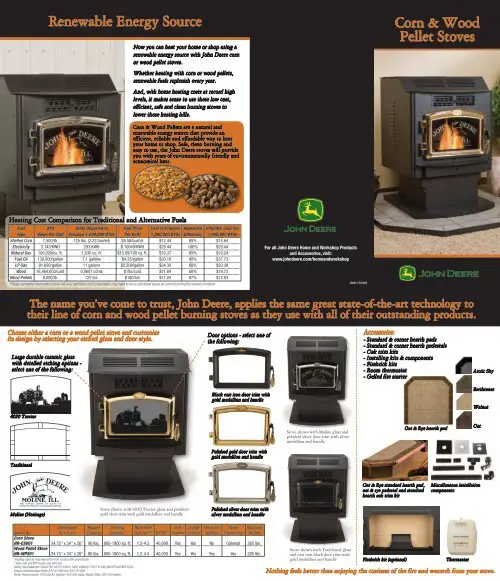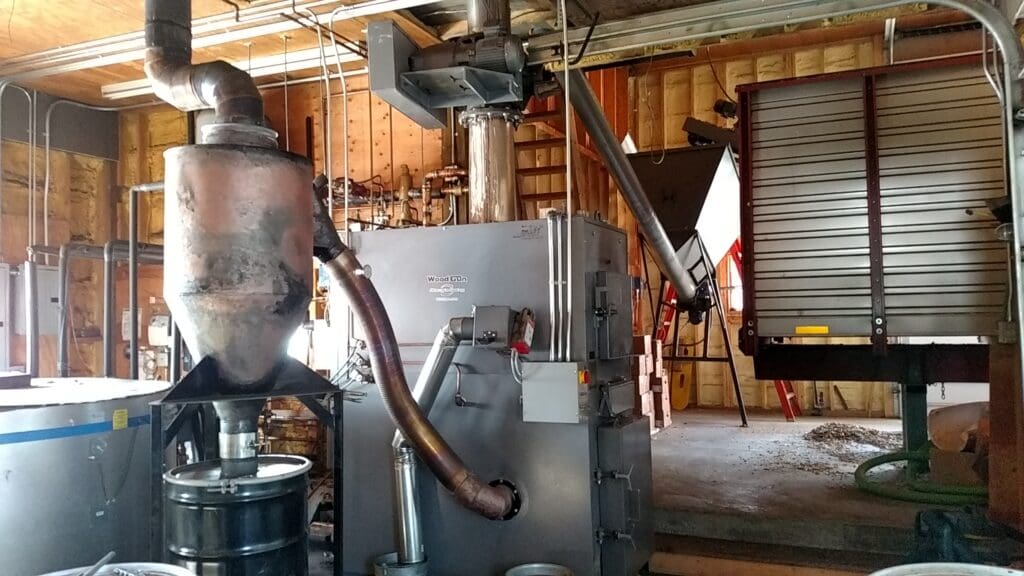You can burn corn in a pellet stove by using a mix of corn with wood pellets. When burning corn, ensure it is clean, dry, and free of chemicals, mold, or mildew.
It’s essential to source the right type of corn for efficient burning in a pellet stove. Burning corn in pellet stoves is a cost-effective and environmentally friendly alternative to traditional heating methods. While corn pellets are generally cheaper than wood pellets, availability and pricing may vary depending on your location.
Some pellet stoves can also burn other pellet fuels like corn, wheat, cherry pits, and grass pellets, providing a versatile heating option. By choosing the right fuel for your stove, you can enjoy efficient and sustainable heating throughout the colder months.


Credit: 8billiontrees.com
Can You Burn Corn In A Pellet Stove?
What kind of corn do you burn in a pellet stove? You can purchase corn from a local farmer or business, ensuring it is clean and dry for optimal burning efficiency. Avoid seed corn, chemically treated corn, old corn, corn with mildew, or mold.
Can you burn corn cobs in a pellet stove? Corn cobs are not ideal for pellet stoves due to their high starch content, which doesn’t convert easily to BTUs. Opt for clean and dry shelled corn, which contains sugar and starch that efficiently converts into heat.
Is it cheaper to burn corn or pellets? Corn pellets are often more cost-effective than wood pellets, but pricing varies by location. Check local availability and prices to determine the most economical option for your pellet stove.
What else can I burn in a pellet stove? Some multi-fuel pellet stoves can burn a variety of pellet fuels, including corn, hulled wheat, cherry pits, waste paper pellets, and grass pellets. Always use the fuel specified for your stove to prevent damage.

Credit: www.amazon.com
Comparison Of Corn And Wood Pellets
Corn and wood pellets are commonly used fuels in pellet stoves, offering different advantages and considerations. Let’s delve into the comparison between these two types of pellets.
Cost
When considering the cost of burning pellets, corn pellets are generally more cost-effective than wood pellets, depending on local availability and pricing.
Availability
It’s essential to check the availability of corn in your area before opting to burn it in a pellet stove. Corn pellets can be sourced locally from farmers or businesses but ensure the corn is clean, dry, and untreated for optimal burning efficiency.
Multi-fuel Option For Pellet Stoves
Pellet stoves have gained popularity due to their efficiency and eco-friendly nature. One appealing feature of some pellet stoves is their ability to burn multi-fuel options, providing homeowners with more flexibility in their heating choices. By utilizing different forms of pellet fuels, such as corn, hulled wheat, cherry pits, waste paper pellets, and grass pellets, these multi-fuel pellet stoves offer a versatile heating solution for various preferences and needs.
Different Forms Of Pellet Fuels
Multi-fuel pellet stoves allow for the burning of various forms of pellet fuels. These can include corn, hulled wheat, cherry pits, waste paper pellets, and grass pellets. It’s important to note that using the specified fuel type for your stove is crucial to prevent any damage or inefficiency.
Precautions
When considering burning different forms of pellet fuels in a pellet stove, it’s essential to take certain precautions. Always ensure the fuel is clean and dry. Additionally, never burn any seed corn, chemically treated corn, old corn, corn with mildew or mold, or any other improper forms of the fuel. This is crucial for both safety and optimal stove performance.
User Experiences And Opinions
When it comes to burning corn in a pellet stove, user experiences and opinions vary. Generally, clean and dry shelled corn is suitable for use, as it converts easily into heat. However, burning corn cobs is not recommended due to the high starch content.
Users also consider availability and pricing before choosing between corn and wood pellets. Some multi-fuel units can even burn various pellet fuels such as hulled wheat and cherry pits, but it’s crucial to use only the specified fuel for your stove to prevent damage.
Hearth.com Forum Discussions
One of the best places to find user experiences and opinions about burning corn in a pellet stove is the Hearth.com Forum. The forum is filled with discussions from people who have tried burning corn in their pellet stoves and are willing to share their experiences. Many users have found success in using a mixture of corn and wood pellets as fuel, as it provides a balanced burn and efficient heat output. They emphasize the importance of using clean and dry corn that is not treated with any chemicals or contaminated with mold or mildew.
Users also discuss the cost-effectiveness of burning corn compared to traditional wood pellets. While it varies depending on location and availability, corn pellets are generally considered to be cheaper. However, users caution that it’s crucial to research and compare the cost and availability of corn in your specific area before making a decision.
Firewood Hoarders Club Community
The Firewood Hoarders Club Community is another great resource to explore user experiences and opinions on burning corn in a pellet stove. Members of this community share their insights and tips on burning corn as an alternative fuel source. It is worth noting that some pellet stoves, known as multi-fuel units, are capable of burning various types of pellet fuels, including corn, hulled wheat, cherry pits, waste paper pellets, and grass pellets.
Members stress the importance of using the recommended fuel specified for your stove to prevent damage and maintain optimal performance. They also mention that while corn cobs are not typically burned in pellet stoves due to their high starch content, shelled corn works well as it contains sugar and starch that easily convert into usable heat.
In conclusion, user experiences and opinions on burning corn in a pellet stove vary, but many have reported success when using a mixture of corn and wood pellets. It is essential to use clean and dry corn that is not treated with chemicals or contaminated, and to compare the cost and availability of corn in your area before making a decision. Additionally, if your pellet stove is a multi-fuel unit, you may have the option to burn various types of pellet fuels besides corn. Always follow the manufacturer’s recommendations for optimal performance and safety.
Considerations For Burning Corn In A Pellet Stove
Burning corn in a pellet stove requires clean, dry shelled corn – not corn cobs – for efficient conversion into usable heat. While corn pellets may offer cost benefits over wood pellets in some areas, it’s crucial to ensure proper fuel type for your stove to avoid damage.
Sourcing Clean And Dry Corn
When considering burning corn in a pellet stove, it is crucial to source clean and dry corn. While you can purchase corn from any local farmer or business, it is important to inform them that the corn will be used for heating in a pellet stove. The corn should be free from any chemicals or treatments, and must not contain any mold, mildew, or other contaminants. It is also essential to avoid using seed corn or corn cobs, as their composition is not ideal for efficient combustion in a pellet stove.Practicality And Maintenance
While burning corn in a pellet stove can be a cost-effective and eco-friendly option, it is essential to evaluate the practicality and maintenance involved. One of the main considerations is the availability and pricing of corn in your area. Depending on the location, corn pellets may be cheaper than wood pellets, making them a more economical choice. However, it is crucial to do research and check the local market to determine the feasibility of using corn as a fuel source.Using The Proper Fuel
It is worth mentioning that some pellet stoves are designed to burn multiple types of fuel, including corn. These multi-fuel units can also burn hulled wheat, cherry pits, waste paper pellets, and grass pellets. However, it is crucial to use only the fuel that is specified for your particular stove to prevent any damage or performance issues. Always consult the manufacturer’s guidelines and recommendations when using alternative fuel sources in your pellet stove. In conclusion, burning corn in a pellet stove can be an efficient and cost-effective heating solution. However, it is important to source clean and dry corn, consider the practicality and maintenance involved, and use the proper fuel as specified by the stove manufacturer. By taking these considerations into account, you can enjoy the benefits of using corn as a renewable and eco-friendly fuel source in your pellet stove.
Credit: alternateheatingsystems.com
Frequently Asked Questions On Can You Burn Corn In A Pellet Stove
What Kind Of Corn Do You Burn In A Pellet Stove?
In a pellet stove, you burn stove corn mixed with wood pellets for efficient heating. Choose clean, dry corn without chemicals, molds, or mildew for safe use.
Can You Burn Corn Cobs In A Pellet Stove?
Yes, you can burn corn cobs in a pellet stove. However, it is more suitable to use clean and dry shelled corn for better heat conversion. Avoid chemically treated, moldy, or old corn. Corn pellets are generally cheaper than wood pellets, depending on availability and pricing in your area.
Is It Cheaper To Burn Corn Or Pellets?
Burning corn pellets is generally cheaper than burning wood pellets, but it depends on your location. Check availability and pricing of corn in your area for accurate comparisons.
What Else Can I Burn In A Pellet Stove?
Some pellet stoves can burn various forms of pellet fuels like corn, hulled wheat, cherry pits, waste paper pellets, and grass pellets. However, it’s important to use only the fuel specified for your stove to prevent damage.
Can You Burn Corn In A Pellet Stove?
Yes, you can burn corn in a pellet stove as long as it’s clean, dry, and not chemically treated.
Conclusion
While burning corn in a pellet stove is possible, it is essential to use clean and dry shelled corn, as other types may pose risks or be less efficient. Understanding the availability and pricing of corn pellets in your area is crucial, as it could impact cost-effectiveness.
Additionally, some pellet stoves can burn various forms of pellet fuels, providing flexibility for users.